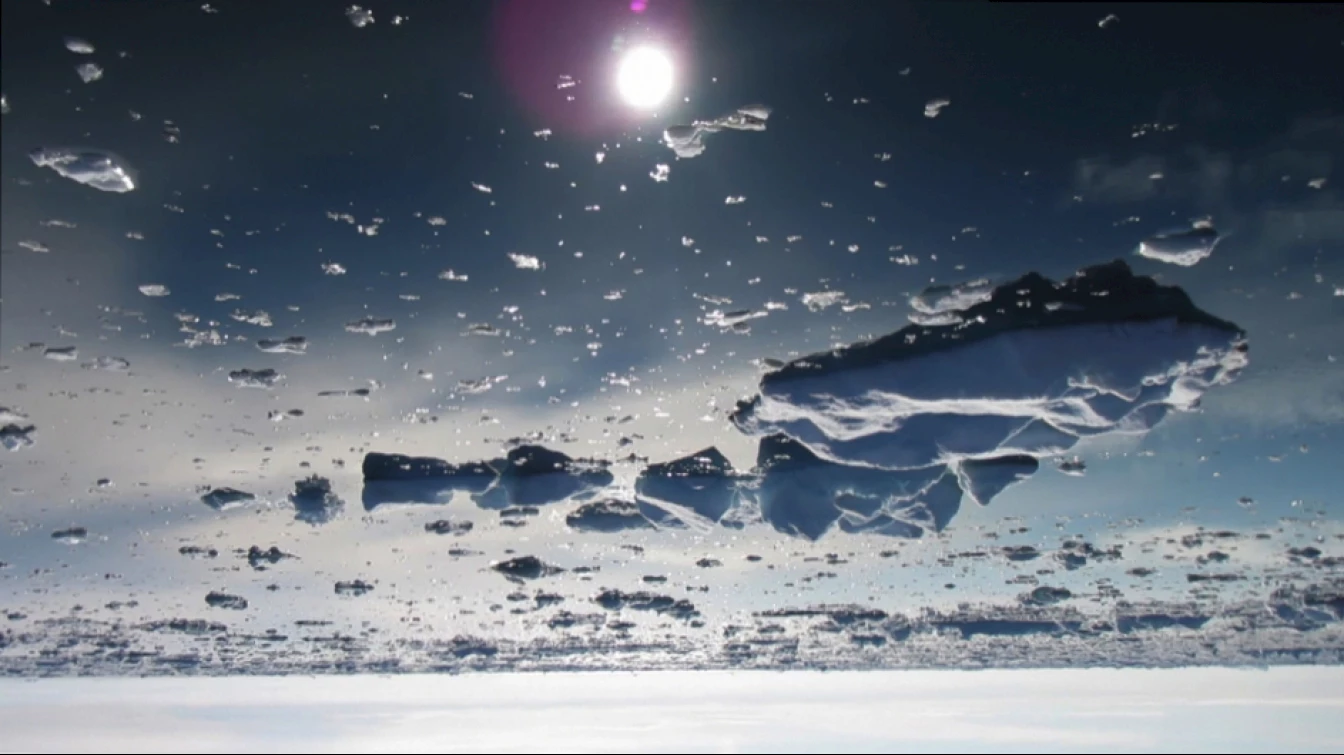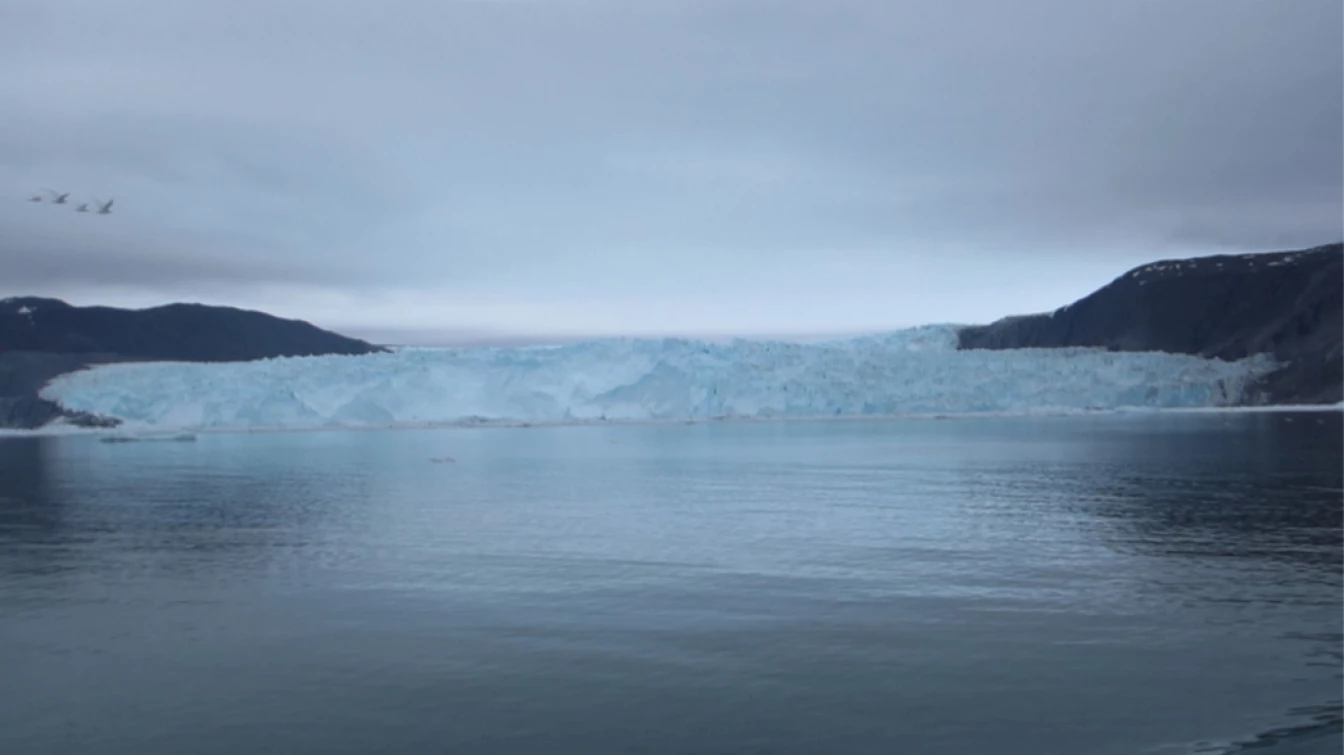
Ursula Biemann, Subatlantic, 2015.

Ursula Biemann, Subatlantic, 2015.

Ursula Biemann, Subatlantic, 2015.
Climate change is no longer a distant hazard looming on the horizon, it is de facto taking place, irrevocably changing the living conditions on the planet with a magnitude and velocity we cannot fully grasp. This speedy course into an unknown future forces us to fundamentally rethink the relationship between humans and the Earth, a matter which has laid dormant in the background for the longest time, occluded by the gigantic technological effort required to draw the societies of the world together and make them global, albeit in uneven and certainly inconclusive ways. Now this complex, artificial and fully imaginary globe that has been constructed in the process fails to resonate with the mighty planetary grammar – de-synced – the Earth a mere obstacle standing in the path of human progress. In this arena, everything is arranged to facilitate human action, prompting a particular modality of narrating the world. Meanwhile, mobilised coevally by natural sciences and the humanities, an inspiring new body of art and writing is emerging that brings Earth on stage. Global warming, with its undisciplined disturbance, interpellates us to engage artistic and scientific paradigms in a conversation and let it infiltrate our imagination and practice. To think with and through art can unravel the role it might play in this process. This text begins with a discussion of a recent video, Subatlantic (2015), followed by some suggestions as to what these considerations could mean for a museum practice in the future. Focusing on global warming, the question I address in this short video is how humans and other species collectively attune to the idea of an unstable living environment where our very subsistence is uncertain. The piece is as much about the physical and natural environment as it is about the psychic space we inhabit and of which we are part because the atmospheric alterations affect not only the physical but also the mental climate on Earth. They force us to think ecologically, as Bruno Latour says, and hence to consider other cosmopolitics, which is what this video attempts to do.
The science-fictional video narrative of Subatlantic is that of a female scientist on a North Atlantic island who is undertaking instrumental observations about a changing environment around the time of the last glacial melts 12,000 years ago. Observing slight disruptions in the interaction between the winds, birds, shores and streams during the 1000 years in which the sea-level steadily rose, she moved her lab further inland along with the first human settlements that were left abandoned and submerged 100 yards deep. The archaic landscapes bear no trace of human presence. The narrated figure who "minutely records her encounter with difference" exists only in the audio dimension. She simultaneously inhabits multiple temporalities that span across millennia, slowly crafting a history that harbours a language still to be announced. Spoken in the off from a submerged Atlantic position, the post-glacial, pre-modern narrative unfolds across the Subatlantic, the proper nomination for the current climatic phase which, superseding the Subboreal, started 2500 years ago and is quickly evolving towards another phase yet to be determined. The point I may seek to establish here is that this post-human condition, where humanism is no longer the dominant premise, reconnects us to infinitely larger, untameable forces that animate extra-historical dimensions. This sudden burst of our time bubble plunges us humans into deep time, into geological and climatic timescales, where we have to index ourselves anew. Subatlantic creates the precondition for a future narrative, providing fuel for the process of imagining a reorientation of human-Earth relations. This unique moment in time calls indeed for new figurations for the profound transformation the planet and its living inhabitants are undergoing.
The observations, at first directed to the physical environment that can be scientifically measured and recorded, move on later in the video to scientific practices of intensities as elucidated in the philosophy of Manuel DeLanda, who snatches from beneath our feet the flat carpet of absolute metric space to propel us into virtual space which adheres to an altogether different model of thought. In Greenland's icescapes, the narrated figure "studies the self-organising flows of matter and energy and the thresholds at which sudden phase transitions occur in physical systems. For instance from a solid to a liquid state. This process involves divers, videographers, and metaphysicians". The post-human condition, then, with its volatile atmospheric climate, is no longer firmly placed in absolute matter, it flows along formless virtual planes arising from unmeasurable, exhalable and constantly recomposing qualities. Hence the observer and the physical reality together become other, mutating their form and ability to operate in and as "a world".
In this narrative, thoughts reconfigure to engage the changing ecology, they merge with frozen methane, become part of weather events, are unhinged by new maritime cohabitations. The words are swaying between phenomenological narrative and scientific reason, melting the gap that has formed by habits over time. "Incubating ideas are finally released from the binding force of the pack". Also released from the dissolving ice sheets are masses of microorganisms that have been trapped in the polar ice for longer than human time. Some are 400,000 years old and still alive. The meltwater bears new genetic material that the world hasn't seen. Released from the deep-freeze, they begin to assemble genetic futures. To be post-human increasingly means to relocate in a new genetic milieu on Earth.
The ocean streams are another vital planetary dynamic that is immediately affected by the ice thaw, impacting hugely on the climate in the North Atlantic. All of these climate- relevant phenomena in the oceans are invisible, either because they take place underwater and out of sight, are too slow or simply too immense to be perceived by the human eye. Art has a role to play in making these processes perceptible in a way that scientific data cannot. Art can send imaginative narratives across the abstract register of the scientific voice. How weather, ice and microorganisms mediate the world is turned into something visible and audible, and hopefully comprehensible, in a way that dramatically draws us into the interval between the Earth and a world, between a terrestrial context and the immediacy of a localised becoming. Suspicious of the corporate dynamics which drove globalisation, ecology-related art has long focused on local ecosystems. Now artists are asked to attend to the planetary connectivity of ecosystems, grasping their place in relation to the larger schemes of forces.
Our female scientist engages in the transformation of the chemical and genetic composition of the earth not by technically intervening, but rather by reworking its tempi, resetting its landmarks, rerouting its premises, and not last, by attuning her own sensorial apparatus to survive under modified conditions. In doing so she embarks on a reconfiguration of the historical terms where the overwhelming focus on recent decades of political history blasts open to embrace the "big history" of planet formation, where archives inevitably include both cultural and natural histories, and exhibitions reestablish the vital relationship between the activities of natural forces, matter, the living world, and humans.
Like our fictional explorer of the Arctic icescape, artists and curators are propelled into domains of knowledge where for the most part they don't feel readily competent: maritime genetics, carbon economics, atmospheric chemistry. Climate change urges art and art institutions to get involved in dynamics that are not comfortably located in the designated human-centric field of cultural inquiry, although altogether disturbingly concrete and pertinent for human continuation. These efforts would not simply seek to ground scientific knowing differently or to draw physical and biological phenomena into a cultural discourse from where they have been effectively discouraged or entirely left out. These efforts aim at breaking down the opposition between science and poetry and instead offer a diverse configuration of that encounter. It comes as no surprise that in this endeavour, artists and theorists currently feel an urge to go back to the moment in history, a couple of hundred years ago, when science split off from other ways of thinking the world and went on developing its own methodologies viewed from a distinct subject position. This bifurcation in the production of knowledge, evolving not unlike a whole new branch of species, is presently undergoing a reevaluation. Solution-oriented thinking that seeks technical answers to human-caused problems is driving the economy these days, it simply is the dominant model for human-earth relationships now. Artists, through small but quickly multiplying gestures, insert a whole range of other motivations and methodologies into the processes that are forcefully shaping the conditions on Earth. In the light of the powerful means and effects afforded by the industry, these efforts may seem irrelevantly small, but they are profoundly meaningful because such artistic research and gestures expose operative paradigms and, more importantly, consider models of thinking and acting with the material world that present alternatives to the economy and technology driven prescriptions.
How will this affect the collecting and exhibiting practices of museums? For a future where human-nonhuman relations are less violent, less destructive, the past will have to be reassembled. This sort of rewriting of history resembles somewhat the rewriting of post- colonial history. Only this time, it is not a matter of admitting formerly excluded groups of human populations to the theatre of significance, it means to radically decentre the human figure altogether. It is difficult to imagine such a place and yet this is what is at stake now. What we can already say is that a common future that we share with everything else would be equally rooted in cultural and natural narratives; the collections of this common world, our heritage, would necessarily include at once cultural and natural histories. Perhaps from there, we can envision a less divided future that can harbour a post-human way of being in the world.
References:
DeLanda, M. 2002, Intensive Science & Virtual Philosophy, Continuum, London.
Latour, B. 2004, "Whose Cosmos, Which Cosmopolitics?", Common Knowledge, vol. 10, no. 3, Duke University Press, Durham, North Carolina.
The views and opinions published here mirror the principles of academic freedom and do not necessarily reflect the views or positions of the L'Internationale confederation and its members.